Dry stone walling - introduction
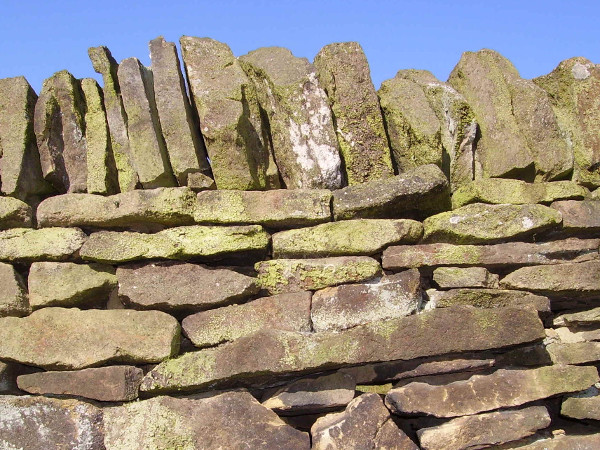
“… dry-stone walls that looped across hillsides and fields with such cursive elegance that they appeared a natural landform.” –
Contents
What is dry stone walling?
It’s the building of walls from natural stone with no adhesive (i.e. cement or mortar). Dry stone walling techniques go back many thousands of years – the Pyramids, for example, were built using a form of very precise dry stone walling. There are walls on the island of Menorca dating from 1500BCE (see pic below).
In the British Isles, the Celts were expert stone builders, and around 1200 there was an expansion with the building of the monasteries. They employed masons to erect perfectly square stone walls around monastery land. The main impetus for the dry stone walls we see today was the Enclosures, as landowners started grabbing previously common land and building walls and hedges around it. The main building period was 1800-1850, when labourers and out-of-work miners were employed to build walls. Miners used the same techniques in the pits – any spare stone dug out was used to wall around the wooden pit props to give extra strength. Most dry stone walls we see today date from at least 1850, and have been subsequently repaired.

Dry stone walls provide field boundaries and shelter for livestock, and they blend into the landscape beautifully because they are made of local, natural stone.
At least 35 countries have dry stone walls, including France, Switzerland, Nepal, Australia, the US and Canada – but the UK is the epicentre. Stone walls are mainly found in higher areas. Most are found along the Pennine backbone of the country, but also in the Cotswolds, Cornwall, Devon, Scotland, Wales, the Lake District, Northumberland and also Ireland. There are around 180,000 miles of dry stone walls in the UK, but around 85-90% are in need of repair and unfit for keeping stock. So there’s a lot of work to do!
Gorgeous film of dry stone walls and techniques from around the world.
There are many different kinds of walls, depending on the stone used – but the basic techniques are the same. Any kind of stone can be used, but the most common are sedimentary rocks such as sandstone and limestone (predominant in the Peak District and the Cotswolds), and metamorphic rocks such as slate (Cornwall and Wales). They are easy to work, and can be split to reveal flat faces. Styles vary due to the properties of the stone. In Scotland (where dry stone walling is called ‘dyking’), there are lots of granite walls. Granite is an igneous rock, and much harder to work, so walls tend to have massive boulders at the base, and a double-skin wall on top of these boulders.

A selection of walling hammers on a section of new wall.
What are the benefits of dry stone walling?
- Durable: should last for over 100 years without needing much attention.
- Local: can be built using local materials and local labour, reducing transport distances, and therefore fuel.
- Beautiful: they add beauty and a unique character to a landscape.
- No cement: or its associated pollution and CO2 emissions.
- Use what’s available: hedges are more suited to lowland areas, but are more difficult to grow over 200m.
- Natural: no manufacturing / factories required.
- Wildlife: walls are a haven for mice, voles, birds, lizards, toads, newts, insects, mosses and lichens.
- Windbreaks: walls can provide shelter in harsh upland conditions for livestock; also, draughts coming through a wall can help dry sheep huddling next to it.

This burial chamber with dry stone walls on the island of Menorca is around 3500 years old.
What can I do?
You can create livestock-proof boundaries on your land, and you can repair existing walls. You can also build dry stone features such as sculptures, arches, cairns and even sheds or bothies. You don’t need planning permission for dry stone structures. A professional waller will put up about 2.5m of wall in a day, but the decision about whether to do the work yourself or hire a professional will probably depend on what you have more of – cash or time.
If you’re lucky, there will be plenty of natural stone on the land. This is obviously the most environmentally-friendly option, as the stone doesn’t have to be transported. The next best option is to contact your nearest quarry and arrange a delivery. You will need about a tonne of stone per metre of wall.
Repairing a stretch of broken dry stone wall.
The recommended spec. for walls is usually 28 inches (71cm) wide at the base, 14 inches (36cm) wide at the top, and 52 inches (132cm) high. There are no regulations covering dry stone walling; the main recommendations come from the Dry Stone Walling Association. Tools required include mattocks, picks, specialist walling hammers (developed by wallers to save labour, shaped to cut and chip away at stone), shovels, crowbars etc. You also need poles or rods to make A-frames (or batter-frames) to get the angle and straightness of the wall right. A typical incline on a wall is 1 in 8.

Course participants building a wall using A-frames and string.
First, sort your stones. Pull out suitable stones to be the half-round cope stones at the top; through stones – long stones that go through the whole wall every metre or so to hold it together; and different sized building stones, starting with large ones at the bottom, and getting smaller as you get higher. Clear a shallow trench for foundations (or strip the wall down if it’s a repair job). As long as there is firm earth, you can start building straight on top of it. Put a couple of A-frames in first, with a string between them. Build the first lift up to 20 inches (50cm) from the ground, using the large stones, then through stones, then smaller stones to the wall height required, and then put cope stones on the top. You will be trying to present a flat face at the outside of the wall. There should be a hollow centre, filled in with very small stones called heartings.

Dry stone wall before and after repair.
There are lots more techniques involved in building dry stone walls, such as pinning and wedging to hold stones in place, bridged joins to ensure the wall’s strength, and trimming stones to shape and size. These skills are probably best obtained by doing rather than reading, and so attending a course is probably a good idea. Other features can be incorporated into walls, such as stiles for people and holes for sheepdogs; and there are other styles of wall, such as single-skinned retaining walls, and Cornish and Welsh varieties that have turf or even hedges on top of the wall.
Grants are available to farmers to build or repair dry stone walls under the Environmental Stewardship scheme. Grants vary according to location, farming activity, etc.
Specialist(s)
Thanks to Les Young of Hadrian’s Dry Stone Walls for information.
The specialist(s) below will respond to queries on this topic. Please comment in the box at the bottom of the page.
 Amanda James began training as a dry stone waller 2010. Based in the Peak District, she has experience of large and small projects, including double-faced, retaining, curved and feature walls. She teaches at the Derbyshire Eco Centre and is enrolled in the School of Natural Building.
Amanda James began training as a dry stone waller 2010. Based in the Peak District, she has experience of large and small projects, including double-faced, retaining, curved and feature walls. She teaches at the Derbyshire Eco Centre and is enrolled in the School of Natural Building.



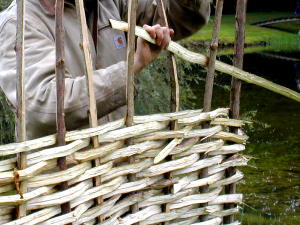

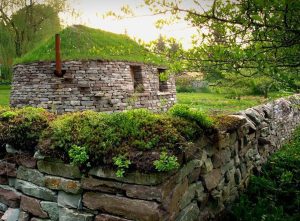

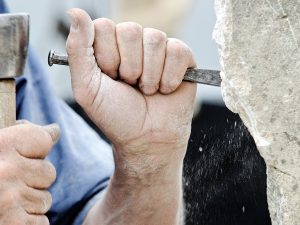
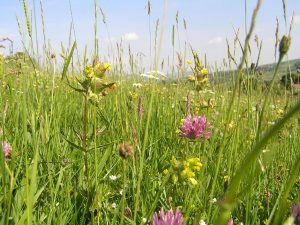
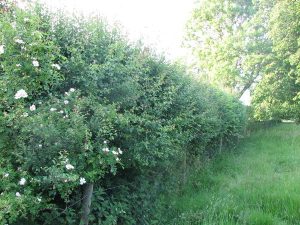
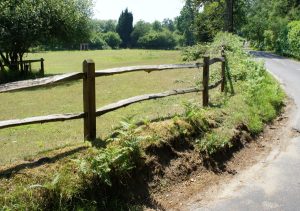
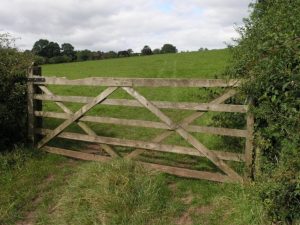
6 Comments
Hi could a dry stone stone base for a straw bale house last longer than say car tyers or compacted gravell ect.
many thanks.
Hi Douglas,
A dry stone wall foundation is not something that Barbara Jones (School of Natural Building) uses. I believe it is because there is too much flexibility/movement when there is no mortar. Using a lime mortar between the stones would allow some flexibility (allowing for the ground settling), but obviously it is no longer “dry”. Barbara uses tyre pillars filled with pea shingle or bricks/stone with a lime mortar and there are other options (like the gravel you mention). The tyres, lime mortared walls and gravel bed foundations are all durable methods as long as everything is done correctly e.g. the tyres are painted with a ultra-violet light resistant paint.
If straw bale building is something you are interested in then I recommend Barbara Jones’ book Building with Straw Bales – A practical manual for self-builders and architects (2015 edition is the most recent). It covers foundations in detail.
Thanks for your question,
Amanda
Your website states that there are around 180,000 miles of dry stone walls in the UK. That’s equal to 180 dry stone walls each 1,000 miles long. What is your source for this information as it seems improbably high to me?
Another way to consider it is; 180,000 miles = 288,000 lineal km of dry stone wall, sufficient to create 720,000 individual square paddocks each 100m x 100m if they were evenly distributed across the country or about 1,440,000 paddocks if in one large block.
UK total land area is 242,495 square km, therefore statistically there is sufficient dry stone walling to build 3 such paddocks in every square km in UK, in which case you could never be more than about 250m from such a paddock anywhere in UK.
I think 180,000 miles is extremely unlikely but am prepared to eat humble pie if the website is correct .
Hi David,
My BTCV Dry Stone Walling handbook (they are now called TCV) says that the then Countryside Commission did a survey of dry stone walls in 1994 and estimated that the total length of walls in England was 68,204 miles. Given the area of England compared to Scotland, N Ireland and Wales, 180,000 does seem to be on the high side. I have included a link to the page I am looking at in the online TCV handbook.
https://www.conservationhandbooks.com/dry-stone-walling/dry-stone-walls-and-conservation/
This is THE dry stone walling guide and we recommend it to our students, so it is a reliable source of information.
Walls are also concentrated in certain areas – half of England’s walls are in N Yorks, Derbys, Cumbria and Cornwall – and you don’t see them everywhere.
Doing a quick search online, there is a 2009 article in the Telegraph which says Britain reportedly has 125,000 miles of walls. They have obviously been talking to wallers, but I don’t know the source of the information. I also don’t know Les Young of Hadrian’s Dry Stone Walls, so I don’t know his source.
Hope this helps!
Amanda
Hello
It says above “You don’t need planning permission for dry stone structures”. Can anyone tell me more about this. And, if possible, point me in the right direction to a website I can see this. It is fairly important, as I’ve recently spent a long time building my dry stone wall and the council are now on my back after a call…..
thanks in advance
Andy
Hi Andy,
I can’t tell you where the statement about not needing planning permission for dry stone structures comes from. The following site gives you information on when planning permission is needed: https://www.planningportal.co.uk/info/200130/common_projects/20/fences_gates_and_garden_walls .
I have worked on a construction site with new dry stone walls and it was stipulated that the garden walls were 1.8m above ground level and the roadside walls were 0.9m above ground level. It is important with visibility splays that the driver’s view – from a vehicle pulling out – is not obstructed. The link above states that a wall by a highway should not be higher than 1m, whilst elsewhere the height should not exceed 2m; otherwise planning permission is needed. I don’t know how high you have built your wall or its location, but I guess if you had to reduce the height of the wall (assuming the wall is battered and not vertical) then you would need longer coping stones.
I hope you manage to resolve the issue satisfactorily,
Amanda